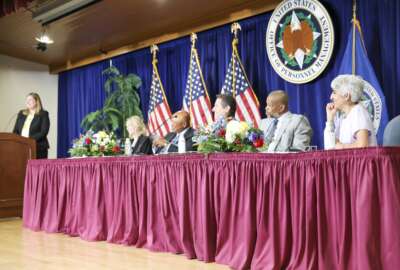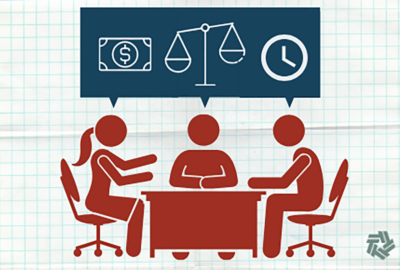Sponsored by WAEPA
How agency chief human capital officers are shaping the future federal workforce
After setting a new tone for an inclusive, agile and engaged federal workforce of the future, agency chief human capital officers are rising to the occasion to...
The federal workforce is now operating differently than it was just a couple of years ago. To try to make sense of those changes and better plan for the future, the Office of Personnel Management set the tone for agencies to develop a workforce that’s inclusive, agile and engaged, with the right skills to enable mission delivery.
But when it comes to the actual implementation of OPM’s vision, agency chief human capital officers (CHCOs) are often the ones rising to the occasion.
It’s no surprise that OPM’s new vision for the federal future of work emphasizes the role of the increasingly common hybrid work environment. At the Department of Veterans Affairs, CHCO Tracey Therit said hybrid work is highly valuable.
“We have seen both now and in the past — and we’ll continue to see in the future — how this hybrid work environment that we are becoming more comfortable and familiar with is helping us both with diversity, and being agile in responding to those things that we don’t expect,” Therit said in a panel interview with Federal News Network as part of WAEPA’s 2023 Annual Meeting.
Presence with a purpose
Although the hybrid work environment seems here to stay, the Biden administration’s recent call on agencies to increase in-office work has caused some concerns among a workforce that has grown accustomed to increased telework during the pandemic. But with those new in-office requirements, agencies like the Energy Department are trying to ensure that time spent in the office makes sense.
“It’s really being deliberate about what we’re doing and how we’re doing it,” Energy CHCO Erin Moore told Federal News Network. “Coming on site to sit on a Teams meeting or a Zoom meeting isn’t presence with a purpose. It’s really trying to work with managers to come up with what works best for them and for their employees … For our teleworking and remote employees … we’ve encouraged the use of collaboration tools, so employees working from home feel like they’re part of the team and an office culture. For our employees who regularly report on site, we’ve made a lot of improvements to our headquarters facilities over the past year, like new common use areas and collaboration centers.”
Aside from continuing hybrid work, Moore said her agency is focused on more resources for employees and upskilling opportunities to both support workforce retention and develop better skills to meet mission with the employees already there.
“We have a robust learning management system that includes courses to strengthen job-related skills as well as assessments to test what employees are learning,” Moore said. “We recently launched a new tool that uses machine learning to support upskilling or reskilling. It actually recommends lessons based on an employee’s role, incorporating their previous learning activities. We make sure that our employees also have access to mentoring programs and rotations to broaden their professional experience.”
Hybrid work doesn’t only affect where employees do their jobs, but also when they do their jobs. CHCOs have seen the use of flexible work schedules as another critical tool to retaining employees and improving engagement.
Supporting a diverse, hybrid federal workforce
“Flexible work schedules are of incredibly great interest to new hires and existing employees,” Therit said. “We’ve partnered a lot with OPM in developing our policies and our guidance around flexible work schedules … We have so many dependent care situations with people being caregivers these days. It’s not just that you’re caring for your children anymore. You may be caring for your parents and trying to figure out how to balance a career and not have to make those sacrifices because of your family circumstances.”
The future federal workforce will also involve incorporating strategies to improve diversity, equity, inclusion and accessibility in government, as part of sweeping DEIA goals that the Biden administration set back in 2021. The Office of Personnel Management’s Carmen Garcia sees a lot of these efforts firsthand in her unique dual position as both the agency’s CHCO and chief diversity officer.
“Our internal DEIA council … comprised of the highest level of agency leadership [and] our employee resource groups and union partners … plays a critical role in ensuring that we are on track with our DEIA strategic plan and all of the wonderful work that is taking place there,” Garcia told Federal News Network. “That includes how we recruit, how we retain, how we sustain and how we leverage data and technology. By having the right folks at the table, we are ensuring that DEIA is embedded in the fabric of everything that we do.”
CHCOs also collaborate across agencies to try to share ideas for the future of work. Regular meetings of the governmentwide CHCO Council help address common concerns and brainstorm ideas for the future. They also keep the dialogue open between employees, supervisors and managers.
“That can help shape what I would like to do moving forward within my organization,” Garcia said. “We’ve been very open as far as my colleagues are concerned. When we hear certain things that resonate from our employees, we share it across the board. That helps shape our individual strategies. Of course, we have formal mechanisms, like surveys, but really making sure that our supervisors and managers are having those conversations with employees is so crucial.”
To watch the full WAEPA 2023 Annual Meeting, go to the meeting event page now.
Copyright © 2025 Federal News Network. All rights reserved. This website is not intended for users located within the European Economic Area.
Drew Friedman is a workforce, pay and benefits reporter for Federal News Network.
Follow @dfriedmanWFED






